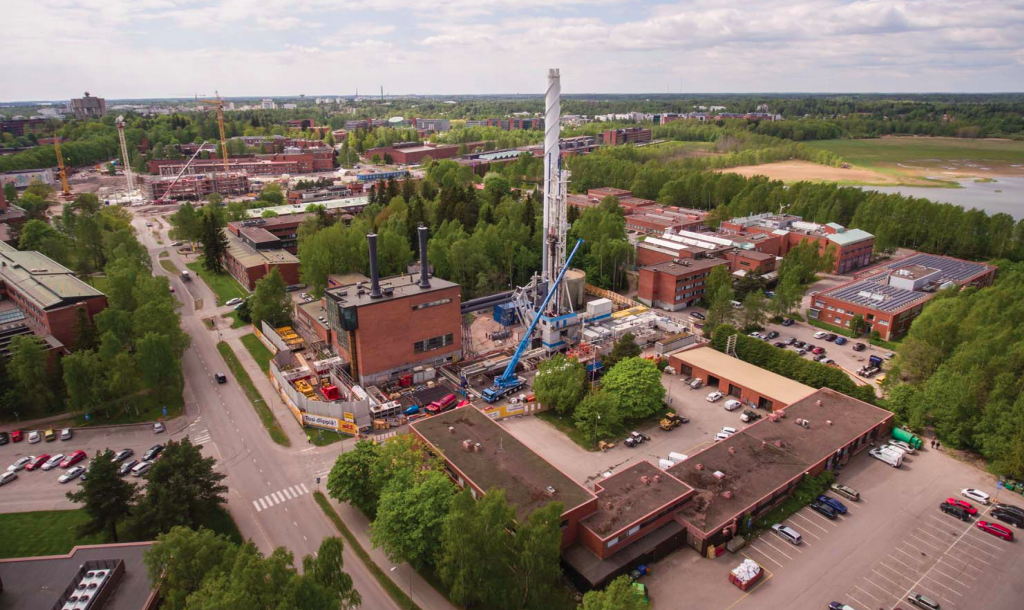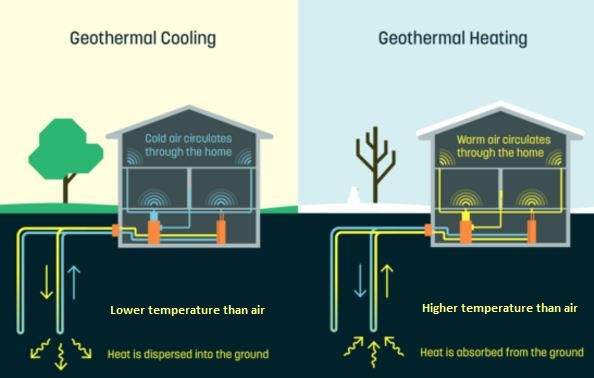Geothermal Heating – The first thing that comes to mind when it comes to geothermal heating is the image of hot volcanic springs many of us have seen. While it seems like something that only exists in remote Nordic landscapes, geothermal heating is a viable, efficient, low-emissions heat source for homes worldwide – and one that is growing in popularity.
What is Geothermal Heating?
Geothermal heating works by harnessing the heat energy just feet below the earth’s surface and converting it into warm air through the use of geothermal heat pumps (GHPs). Also known as GeoExchange, earth-coupled, ground, or water-source heat pumps, are driven by a small amount of electricity (never natural gas) and are by far the most efficient way to heat and cool a home.
That’s right, geothermal heat pumps not only replace your expensive, inefficient, polluting gas furnace, but they also serve as your air conditioner—and some can also drive your water heater at practically no additional cost.
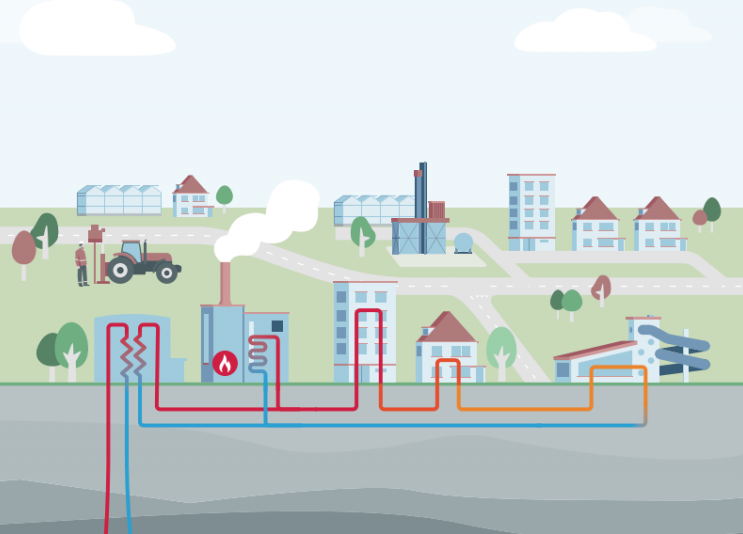
How Geothermal Heating Works?
So how exactly does geothermal heating function? The earth’s surface absorbs about 50 percent of the sun’s energy into the ground. This, and the radioactive decay of minerals, produces geothermal energy. Residential geothermal heating works by burying pipes filled with liquid several feet below the surface. This is done in your yard or many cases, under your driveway. The liquid in the pipes/tubes absorbs this trapped heat energy and transfers it to the geothermal heat pump in your basement. The GHP removes the heat from the liquid and passes it on to the dwelling the same way a furnace does, through the forced-air ductwork.
Because they don’t burn fossil fuels and require very little electricity to operate, geothermal heat systems are up to four times more efficient than traditional furnaces.
Ground source heat systems work by pumping water containing antifreeze (called glycol) around a ground loop pipe that is buried in your garden. The length of the loop you require will depend on the size of your property and the level of heat you need to achieve a comfortable temperature.
Longer loops will draw more warmth from the ground, but they need more space. If you have enough room in your garden, the loop can be buried underground in a horizontal trench. However, if you don’t have a big enough area in which to do this, another option is to lay the pipe in a series of vertical boreholes instead. These reach much deeper into the ground.
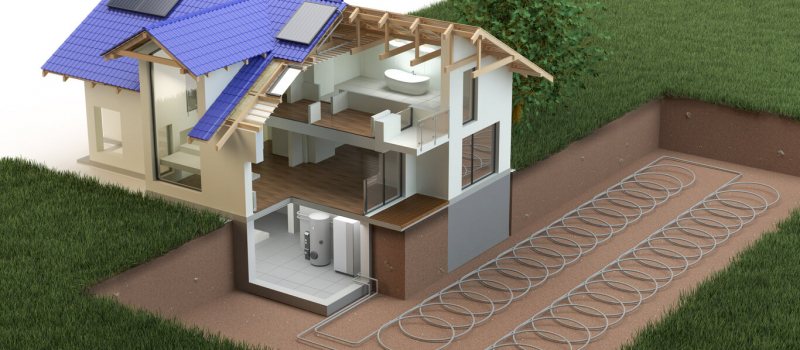
The space you need to install a horizontal loop of pipe or the depth you have to dig down for a borehole will depend on a variety of factors. Your heat pump installer will ensure that the design of your system meets the heat requirements of your home and is suitable for local conditions.
As the antifreeze mixture travels through this loop, it picks up heat from the ground. This energy is then passed through a heat exchanger into a heat pump. These pumps work like a refrigerator but in reverse. They take the energy that has come from the ground and transfer it into your home. Particularly environmentally responsible systems are now available that run these heat pumps using power generated on-site by renewable sources such as photovoltaic solar panels, meaning they don’t have to rely on mains energy.
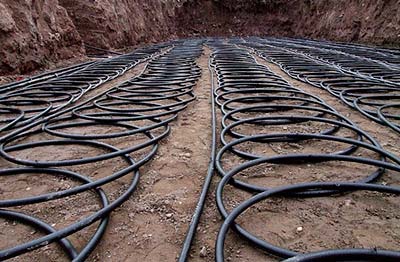
Geothermal solutions that also provide a cooling function simply work in reverse during spells of hot weather, transferring heat energy from the home into the cooler ground and making your living environment more comfortable as a result.
Geothermal Heating Systems
Geothermal heating systems can be set up in a variety of formats. Here are a few ways in which geothermal heating can be configured:
Closed-Loop System
This format consists of continuous underground pipes filled with a liquid solution that transfers geothermal energy to the heat pump. This system can be set up in a vertical or horizontal arrangement.
- Vertical
This is the most common form of a geothermal heat system, as it requires less outdoor space. Holes are drilled often by a good driller and the continuous piping loops are then installed vertically.
- Horizontal
In this model, the continuous piping for the closed-loop system is laid out in the yard in a horizontal configuration. This has the potential to reduce front-end costs, as it can be installed with a backhoe rather than a drilling rig.
Open-Loop System
This geothermal system uses groundwater as its heat source. Rather than a liquid circulated in closed pipes to deliver heat to the pump, an open-loop pumps groundwater directly to the heat pump to transfer the geothermal energy.
Pond/Lake Hybrid System
In a form of an open-loop system, the pond/lake hybrid relies on an ample pond or lake to provide the geothermal energy. This pond or lake water is connected to the heat pump.
Domestic Geothermal heating systems can be a great way to heat a home, replace a furnace, and are labeled as money savers. Question is, are they worth the hype? Here’s a quick view first of how they operate.
Starting at depths of between 6 and 10 meters, the temperature of the earth is no longer influenced by variations in surface temperature and stays relatively constant at around 8 to 10 C. So the underlying principle of geothermal heating and cooling is to use that consistent interior earth temperature to balance our wildly varying North American & Canadian surface temperatures.
With the use of heat pumps, geothermal heating, and cooling systems extract heat energy and transfer it into buildings, saving approximately 50 to 60% on heating and cooling costs, depending on the fuel being compared to.
In summer months, geothermal cooling functions in a similar way to standard air conditioning, only heat is not simply ejected into the outside air but rather deposited deep in the ground for future use. The result is guilt-free air conditioning because the heat extracted in summer months is used to warm the earth deep below, heat which will increase the efficiency of the ground source heat pump in winter months.
Vertical closed-loop geothermal systems have a sealed U-shaped pipe of high-density polyethylene that carries a heat transfer fluid (usually a water/methanol mix) in a continuously circulating loop allowing an exchange of heat by conduction. As the liquid returns to the surface, either heated or cooled depending on the season, the additional or reduced amount of heat in the water is used to condition the home. The required depth for this system is generally 300 feet or more, and the cost is calculated by the foot. Through the nose, but by the foot.
Horizontal closed-loop geothermal systems function in the same manner as vertical systems, except that pipes run back and forth 6 to 10 feet underground. Installation involves excavating trenches (at least 300 feet of them), rather than digging a well.
Horizontal ground source heat pump systems can be cheaper to install but require a significant amount of space, and it does some pretty intense damage to any ecosystems that lay in their intended path. For a given length of pipe, horizontal loop systems are a bit less efficient than vertical loop systems, as they can be more easily affected by surface temperatures. The other downside is that if or when there’s a leak in the circuit, with a horizontal mat or grid-style system the whole garden area has to be dug up again in search of a tiny leak that is losing the system pressure.
Open-loop geothermal systems use ground water pumped directly from a supply well (75 to 100 feet deep) to draw and inject heat. Water is pumped out of the first well, and after the heat exchange is carried out, it gets injected into the second well.
Open-loop systems have very high thermal efficiency and installation can be up to 50% less expensive than vertically closed-loop systems. However, conditions necessary for the proper function of these systems are rarely found in urban areas, as they require an abundant source of groundwater and a high water table.
The Extent of Geothermal Heat Generation
Geothermal heating systems don’t get as hot as conventional boilers. Whereas regular boiler systems tend to operate at around 70-80°C, ground source heat pump solutions usually operate at approximately 35-50°C. However, this doesn’t mean that you will feel the chill in winter if you have a geothermal system. These solutions are designed to be highly efficient and to provide continual heat during cold weather.
That said, it’s important to be aware that because they work at lower temperatures, these systems are typically best suited to well-insulated and draught-proofed homes, and they can perform better with larger radiators or underfloor heating than with standard radiators.
The Benefits of Geothermal Heating
There are many benefits associated with geothermal heating. One of the most important is the fact that it reduces the consumption of fossil fuels and is therefore kinder to the planet than conventional heating solutions. A related advantage is that it helps you to reduce your fuel bills, particularly if you are replacing a conventional electric heating system. It can also give you added peace of mind that you aren’t at the mercy of future potential fuel price hikes.
In addition, a ground source heat pump could mean you qualify for the government’s Renewable Heat Incentive. This scheme, which was launched in 2014, provides financial support to owners of renewable heating systems. If you qualify, you could receive quarterly payments over seven years. An average four-bedroom detached home with a heat pump system could receive over £2,000 a year under this scheme.
Another benefit is the reliability of these solutions. Once installed, all they require is an annual check to ensure that they’re running correctly. The loops can last for generations, and the fans, compressors, and pumps are designed for long-term use with very little maintenance.
These systems are flexible too. They can be operated as standalone units or used in conjunction with your existing heating system to provide an extra source of heat.
Cost Efficiency of Geothermal Heating
That truly depends on the size of the project to heat. No geothermal system is cheap to install, and because it offers only a reduction in consumption, the return on investment is only viable for larger buildings. For this reason geothermal is more suitable for commercial or multi-unit residential projects of substantial size.
A home would have to be quite large, and somewhat poorly insulated to make it pay for itself in a reasonable time frame. In many cases, particularly with moderately-sized new homes being built, that large of a financial investment towards energy efficiency could offer much greater returns if put towards heat retention instead – better windows, additional home insulation in new build, insulating existing walls from the outside during a house renovation, or better tapes and membranes for air sealing, etc.
Ballpark pricing for a geothermal system: For an averaged size home (2000 sq. ft.) a GSHP will easily cost $30,000 to have installed, and that is in exchange for a monthly saving of about 50% on the heating bill. So payback for the average single-family home is simply too far away to make this a financially competitive option with all but the highest consuming homes – and even then only when the boiler or furnace has failed and needs replacement.
That same investment of $25,000 (or perhaps less) in a better thermal envelope would likely reduce heating bills easily by 70 or 80%, perhaps more. Geothermal energy is an excellent global technology, but poorly insulated single-family homes will get far more bang for the buck if the money is put into insulation instead, or balanced between energy-saving renovations and high-efficiency heat pumps.
Geothermal Heating Q&A
Is geothermal heating only possible in specific geographical locations?
Further, a common misconception about geothermal heating is that it is only available in specific geographical locations. While regions close to volcanic activity (often found along tectonic plate boundaries) have a higher output of geothermal energy and are often host to utility-scale geothermal electric power plants, homes anywhere can take advantage of residential geothermal technology to heat and cool their home at low cost with very few emissions.
What is the annual coefficient of performance?
If you’re considering buying a ground source heating system, you’re likely to come across the phrase annual coefficient of performance (COP). This is a way of assessing the efficiency of a system and it’s calculated by comparing the amount of heat provided by the system with the total electricity demand of the heat pump.
The higher the coefficient, the more efficiently your heat pump system is working.
Why would geothermal HVAC systems be categorized as renewable because they use electricity?
Geothermal HVAC systems use only one unit of electricity to move up to five units of cooling or heating from the earth to a building.
Is it true that technologies such as photovoltaic and wind power are better renewable solutions compared to geothermal HVAC systems?
Fact: Geothermal HVAC systems remove four times more kilowatt-hours of consumption from the electrical grid per dollar spent than photovoltaic and wind power add to the electrical grid. Those other technologies can certainly play an important role, but geothermal HVAC is often the most cost-effective way to reduce the environmental impact of conditioning spaces.
How much of space is required to place the polyethylene piping earth loops for geothermal HVAC needs?
Fact: Depending on the characteristics of the site, the earth loop may be buried vertically, meaning a little above-ground surface is needed. Or, if there is an available aquifer that can be tapped into, only a few square feet of real estate are needed. Remember, the water is returned to the aquifer whence it came after passing over a heat exchanger, so it is not “used” or otherwise negatively impacted.
How noisy are geothermal heat pumps?
Fact: The systems run very quietly and there is no equipment outside to bother neighbors.
How long will geothermal HVAC systems last?
Fact: Earth loops can last for generations. The heat-exchange equipment typically lasts decades, since it is protected indoors. When it does need to be replaced, the expense is much less than putting in an entire new geothermal system, since the loop or well is the most pricey to install. New technical guidelines eliminate the issue of thermal retention in the ground, so heat can be exchanged with it indefinitely. In the past, some improperly sized systems did overheat or over-cool the ground over time, to the point that the system no longer had enough of a temperature gradient to function.
Can geothermal HVAC systems be used for cooling as well?
Fact: They work just as effectively in cooling and can be engineered to require no additional backup heat source if desired, although some customers decide that it is more cost-effective to have a small backup system for just the coldest days if it means their loop can be smaller.
Is it possible for geothermal HVAC systems to supply multiple supply loads simultaneously?
Fact: Systems can be designed to handle multiple loads simultaneously.
What medium runs through geothermal HVAC systems lines and loops?
Fact: Most systems use only water in the loops or lines.
What is the rate of water consumption in geothermal HVAC systems?
Fact: Geothermal systems consume no water. If an aquifer is used to exchange heat with the earth, all the water is returned to that same aquifer. In the past, some “pump and dump” operations wasted water after passing over the heat exchanger, but those are exceedingly rare now. When applied commercially, geothermal HVAC systems eliminate millions of gallons of water that would otherwise have been evaporated in cooling towers in traditional systems.
How much does it cost to install a geothermal HVAC system?
Fact: Federal and local incentives typically amount to between 30 and 60 percent of total geothermal system cost, which can often make the initial price of a system competitive with conventional equipment. Standard air-source HVAC systems cost around $3,000 per ton of heating or cooling capacity, during new construction (homes usually use between one and five tons). Geothermal HVAC systems start at about $5,000 per ton and can go as high as $8,000 or $9,000 per ton. However, new installation practices are reducing costs, to the point where the price is getting closer to conventional systems under the right conditions.
Buy Equipment or Ask for a Service
By using Linquip RFQ Service, you can expect to receive quotations from various suppliers across multiple industries and regions.
Click Here to Request a Quotation From Suppliers and Service Providers
Read More On Linquip

